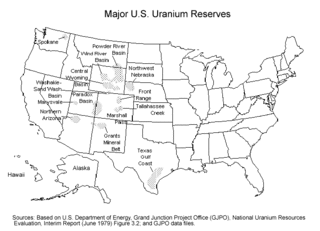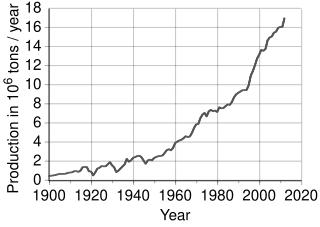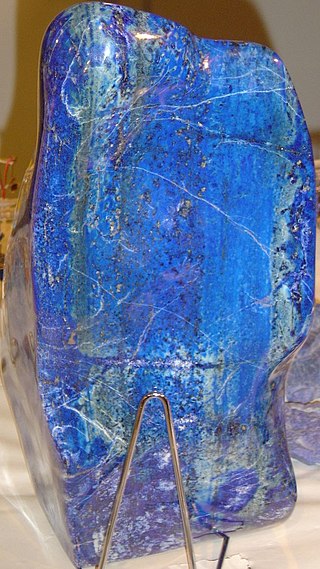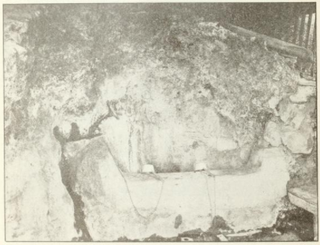Related Research Articles

Jeffrey C. Wynn is a research geophysicist with the United States Geological Survey (USGS). He is currently based in the Cascades Volcano Observatory in Vancouver, WA, one of the five USGS volcano observatories in the United States .

Carbonatite is a type of intrusive or extrusive igneous rock defined by mineralogic composition consisting of greater than 50% carbonate minerals. Carbonatites may be confused with marble and may require geochemical verification.
Type locality, also called type area, is the locality where a particular rock type, stratigraphic unit or mineral species is first identified. If the stratigraphic unit in a locality is layered, it is called a stratotype, whereas the standard of reference for unlayered rocks is the type locality.
The Melozitna River is a 135-mile (217 km) tributary of the Yukon River in the U.S. state of Alaska. It flows generally southwest from the Ray Mountains to its mouth near the city of Ruby.

Uranium mining in the United States produced 173,875 pounds (78.9 tonnes) of U3O8 in 2019, 88% lower than the 2018 production of 1,447,945 pounds (656.8 tonnes) of U3O8 and the lowest US annual production since 1948. The 2019 production represents 0.3% of the anticipated uranium fuel requirements of the US's nuclear power reactors for the year.

Uranium mining in Utah, a state of the United States, has a history going back more than 100 years. Uranium mining started as a byproduct of vanadium mining about 1900, became a byproduct of radium mining about 1910, then back to a byproduct of vanadium when the radium price fell in the 1920s. Utah saw a uranium boom in the late 1940s and early 1950s, but uranium mining declined in the 1980s. Since 2001 there has been a revival of interest in uranium mining, as a result of higher uranium prices.

Peak copper is the point in time at which the maximum global copper production rate is reached. Since copper is a finite resource, at some point in the future new production from mining will diminish, and at some earlier time production will reach a maximum. When this will occur is a matter of dispute. Unlike fossil fuels, copper is scrapped and reused, and it has been estimated that at least 80% of all copper ever mined is still available.

Mining in Afghanistan was controlled by the Ministry of Mines and Petroleum, prior to the August 15th takeover by the Taliban. It is headquartered in Kabul with regional offices in other parts of the country. Afghanistan has over 1,400 mineral fields, containing barite, chromite, coal, copper, gold, iron ore, lead, natural gas, petroleum, precious and semi-precious stones, salt, sulfur, lithium, talc, and zinc, among many other minerals. Gemstones include high-quality emeralds, lapis lazuli, red garnet and ruby. According to a joint study by The Pentagon and the United States Geological Survey, Afghanistan has an estimated US$1 trillion of untapped minerals.
The Ordovician Kittatinny Formation or Kittatinny Limestone is a dolomitic limestone formation in New Jersey. The Kittatinny Limestones are located primarily in the Kittatinny Valley where it lies above the Ordovician Martinsburg Formation within the long valley running from Picatinny Arsenal in Rockaway Township, southwest toward Chester Township. It overlies the Cambrian Hardyston Quartzite.

The Bedford Shale is a shale geologic formation in the states of Ohio, Michigan, Pennsylvania, Kentucky, West Virginia, and Virginia in the United States.

The mineral mining industry is a crucial piece of the Economy of Niger. Exports of minerals consistently account for 40% of exports.
The mineral-mining industry of Panama accounted for about 1% of the country's GDP in 2006. This does not include any manufacturing of mineral commodities, such as cement or petroleum refinery products.

Hough Springs is a set of springs that was turned into a resort in the 19th century in Lake County, California.

The Shonkin Sag is a prehistoric fluvioglacial landform located along the northern edge of the Highwood Mountains in the state of Montana in the United States. The Sag is a river channel formed by the Missouri River and glacial meltwater pouring from Glacial Lake Great Falls. It is one of the most famous prehistoric meltwater channels in the world.
Helen Margaret Duncan was a geologist and paleontologist with the United States Geological Survey from 1945 to 1971, where she worked in the Paleontology and Stratigraphy Branch. Duncan was considered one of the strongest women in the Cincinnati geology department; her contributions to the Lipalian Research Foundation and the Pick and Hammer shows were additional work of her time. Duncan paved the path for many geology scholars to follow with her discoveries on fossil records and her studies in paleontology and stratigraphy.

The Juneau gold belt is located in the southeastern portion of the U.S. state of Alaska. This belt is approximately 100 miles (160 km) in length, north/northwest-trending, and extends from Berners Bay southeastward to Windham Bay, 60 miles (97 km) southeast of Juneau, and includes Douglas Island. The belt contains over 200 gold-quartz-vein deposits with production nearing 7,000,000 ounces (200,000,000 g) of gold. More than three-quarters of Alaska's lode gold was mined from the Juneau gold belt.

Colorado mining history is a chronology of precious metal mining, fuel extraction, building material quarrying, and rare earth mining.
John Beaver Mertie Jr. was a geologist for the USGS and a professor at Johns Hopkins University. He spent 30 years mapping Alaska in the early 1900s, so much so that a mountain range was named in his honour in 1986: the Mertie Mountains located in the Yukon–Charley Rivers National Preserve. The mountains extend 187 kilometres (116 mi) by 176 kilometres (109 mi), from the Tanana River to the Yukon River; the United States Board on Geographic Names' dedication to Mertie read he "did pioneering geologic studies in Alaska for over 40 years, with a major portion of the studies pertaining to the area of these mountains".
The Pachuca Range is a mountain range in the Sierra Madre Oriental of central Mexico, in the state of Hidalgo.
Arolik is a former Yup'ik settlement and ghost town in Bethel Census Area, Alaska, United States. It was located at the North mouth of Arolik River adjacent to the shore of Kuskokwim Bay. The site is approximately 4 miles south of the city of Quinhagak. It was first surveyed for the 1880 U.S. Census by Ivan Petroff and reported as "Agaligamute".
References
- ↑ "The Venezuela-China relationship, explained: Belt and Road | Part 2 of 4". SupChina. 14 January 2019. Archived from the original on 24 June 2019. Retrieved 24 June 2019.
- ↑ Dolan, Thomas James, ed. (2017). "Worldwide Activities". Molten Salt Reactors and Thorium Energy. Woodhead Publishing. p. 766. ISBN 9780081012437.
- ↑ USGS Minerals Yearbook. Washington: GPO. 1972. p. 1206.
- ↑ Geological Survey Professional Paper. U.S. Government Printing Office. 1982. p. 49.
- ↑ "Cerro Impacto". REE - Rare earth element mines, deposits, and occurrences. USGS.
- ↑ U.S. Geological Survey Bulletin, Issues 2122-2127. Washington: U.S. Government Printing Office. 1983. p. O13.
- ↑ Lavie, Henrique J. (1982). "An Overview of Problems and Requirements - The Outlook from Venezuela". Resources for the Twenty-first Century: Proceedings of the International Centennial Symposium of the United States Geological Survey, Held at Reston, Virginia, October 14-19, 1979, Issue 1193. U.S. Geological Survey. p. 49.